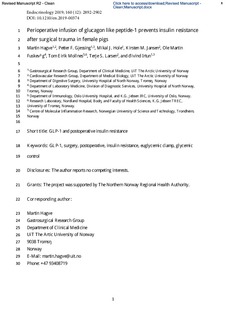Perioperative infusion of glucagon-like peptide-1 prevents insulin resistance after surgical trauma in female pigs
Hagve, Martin Iversen; Gjessing, Petter Fosse; Hole, Mikal Jacob; Jansen, Kirsten M; Fuskevåg, Ole Martin; Mollnes, Tom Eirik; Larsen, Terje S; Irtun, Øivind
Journal article, Peer reviewed
Accepted version

Åpne
Permanent lenke
http://hdl.handle.net/11250/2642110Utgivelsesdato
2019Metadata
Vis full innførselSamlinger
Sammendrag
Insulin resistance is an independent negative predictor of outcome after elective surgery and increases mortality among surgical patients in intensive care. The incretin hormone glucagon-like peptide-1 (GLP-1) potentiates glucose-induced insulin release from the pancreas but may also increase insulin sensitivity in skeletal muscle and directly suppress hepatic glucose release. Here, we investigated whether a perioperative infusion of GLP-1 could counteract the development of insulin resistance after surgery. Pigs were randomly assigned to three groups; surgery/control, surgery/GLP-1, and sham/GLP-1. Both surgery groups underwent major abdominal surgery. Whole-body glucose disposal (WGD) and endogenous glucose release (EGR) were assessed preoperatively and postoperatively using D-[6,6-2H2]-glucose infusion in combination with hyperinsulinemic euglycemic step-clamping. In the surgery/control group, peripheral insulin sensitivity (i.e., WGD) was reduced by 44% relative to preoperative conditions, whereas the corresponding decline was only 9% for surgery/GLP-1 (P < 0.05). Hepatic insulin sensitivity (i.e., EGR) remained unchanged in the surgery/control group but was enhanced after GLP-1 infusion in both surgery and sham animals (40% and 104%, respectively, both P < 0.05). Intraoperative plasma glucose increased in surgery/control (∼20%) but remained unchanged in both groups receiving GLP-1 (P < 0.05). GLP-1 diminished an increase in postoperative glucagon levels but did not affect skeletal muscle glycogen or insulin signaling proteins after surgery. We show that GLP-1 improves intraoperative glycemic control, diminishes peripheral insulin resistance after surgery, and suppresses EGR. This study supports the use of GLP-1 to prevent development of postoperative insulin resistance.